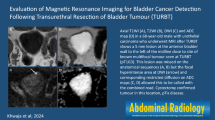Abstract
Purpose
To evaluate the utility of computed tomography (CT) and magnetic resonance imaging (MRI) in detecting male urethral recurrence (UR).
Materials and methods
Between December 2008 and March 2016, 12 men (age range 61–85 years; median, 74 years) with urethral bloody discharge or pain were histologically confirmed as UR after radical cystectomy due to urothelial carcinoma. Of these patients, eight underwent both CT and MRI. The remaining four patients underwent CT only. CT and MRI were compared regarding UR detection rate. CT and MRI were also evaluated to determine which modality was more accurate for depicting UR. UR detection rate of each MRI sequence were recorded. Standard reference was biopsy or urethrectomy in 11 patients and size change in one patient after treatment.
Results
UR detection rate with CT was 41.7% (5/12), while that with MRI was 100% (8/8) (p = 0.0147). Of the eight patients who were diagnosed UR with MRI, six were detected with MRI alone and two with both MRI and CT (p = 0.0313). UR detection rates of T2-weighted, T1-weighted, diffusion-weighted, and contrast-enhanced MRI were 87.5% (7/8), 62.5% (5/8), 100% (5/5), and 87.5% (7/8), respectively.
Conclusion
MRI is superior to CT in detecting male URs in symptomatic patients after radical cystectomy. T2-weighted, diffusion-weighted, and contrast-enhanced MRI sequences are useful for detecting male UR.


Similar content being viewed by others
References
Stenzl A, Bartsch G, Rogatsch H (2002) The remnant urothelium after reconstructive bladder surgery. Eur Urol 41:124–131
Boorjian SA, Kim SP, Weight CJ, et al. (2011) Risk factors and outcomes of urethral recurrence following radical cystectomy. Eur Urol 60:1266–1272
Chan Y, Fisher P, Tilki D, Evans CP (2016) Urethral recurrence after cystectomy: current preventative measures, diagnosis and management. BJU Int 117:563–569
Mazzonetto M, De Antoni M, Veronese F, Lavelli D (1991) Cystectomy and internal urinary diversion in bladder neoplasm. Role of CT in the follow-up. Radiol Med 82:308–314 (308 pages over)
Dhar NB, Jones JS, Reuther AM, et al. (2008) Presentation, location and overall survival of pelvic recurrence after radical cystectomy for transitional cell carcinoma of the bladder. BJU Int 101:969–972
Shinagare AB, Sadow CA, Silverman SG (2013) Surveillance of patients with bladder cancer following cystectomy: yield of CT urography. Abdom Imaging 38:1415–1421
Sung DJ, Kim YH, Cho SB, et al. (2006) Obliterative urethral stricture: MR urethrography vs. conventional retrograde urethrography with voiding cystourethrography. Radiology 240:842–848
Osman Y, El-Ghar MA, Mansour O, Refaie H, El-Diasty T (2006) Magnetic resonance urethrography in comparison to retrograde urethrography in diagnosis of male urethral strictures: is it clinically relevant? Eur Urol 50:587–593; discussion 594
Park BK, Kim CK, Lee SW (2010) Evaluation of anterior urethral stricture using thick slab SSFSE MR urethrography. Acta Radiol 51:1157–1162
Ryu J, Kim B (2001) MR imaging of the male and female urethra. Radiographics 21:1169–1185
Kim B, Kawashima A, LeRoy AJ (2007) Imaging of the male urethra. Semin Ultrasound CT MR 28:258–273
Stewart SB, Leder RA, Inman BA (2010) Imaging tumors of the penis and urethra. Urol Clin North Am 37:353–367
Varol C, Thalmann GN, Burkhard FC, Studer UE (2004) Treatment of urethral recurrence following radical cystectomy and ileal bladder substitution. J Urol 172:937–942
Katzberg RW, Haller C (2006) Contrast-induced nephrotoxicity: clinical landscape. Kidney Int 69:S3–S7
Roberts DR, Lindhorst SM, Welsh CT, et al. (2016) High levels of gadolinium deposition in the skin of a patient with normal renal function. Invest Radiol 51:280–289
Kim CK, Park BK, Lee HM, Kwon GY (2007) Value of diffusion-weighted imaging for the prediction of prostate cancer location at 3T using a phased-array coil: preliminary results. Invest Radiol 42:842–847
Park BK, Lee HM, Kim CK, Choi HY, Park JW (2008) Lesion localization in patients with a previous negative transrectal ultrasound biopsy and persistently elevated prostate specific antigen level using diffusion-weighted imaging at three Tesla before rebiopsy. Invest Radiol 43:789–793
El-Assmy A, Abou-El-Ghar ME, Refaie HF, Mosbah A, El-Diasty T (2012) Diffusion-weighted magnetic resonance imaging in follow-up of superficial urinary bladder carcinoma after transurethral resection: initial experience. BJU Int 110:E622–627
Takeuchi M, Sasaki S, Naiki T, et al. (2013) MR imaging of urinary bladder cancer for T-staging: a review and a pictorial essay of diffusion-weighted imaging. J Magn Reson Imaging 38:1299–1309
Author information
Authors and Affiliations
Corresponding author
Ethics declarations
Funding
No funding was received for this study.
Conflict of interest
The authors declare that they have no conflict of interest.
Ethical approval
All procedures performed in studies involving human participants were in accordance with the ethical standards of the institutional and/or national research committee and with the 1964 Helsinki declaration and its later amendments or comparable ethical standards. Informed consent was waived because of retrospective design.
Informed consent
Statement of informed consent was not applicable since the manuscript does not contain any patient data.
Rights and permissions
About this article
Cite this article
Park, J.J., Park, B.K. The utility of CT and MRI in detecting male urethral recurrence after radical cystectomy. Abdom Radiol 42, 2521–2526 (2017). https://doi.org/10.1007/s00261-017-1159-7
Published:
Issue Date:
DOI: https://doi.org/10.1007/s00261-017-1159-7




